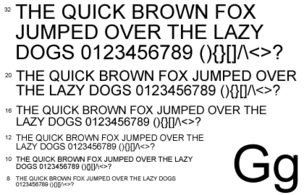This section has multiple issues. Please help improve it or discuss these issues on the talk page. (Learn how and when to remove these messages)
|
CTA-708 (formerly EIA-708 and CEA-708) is the standard for closed captioning for ATSC digital television (DTV) viewing in the United States and Canada. It was developed by the Consumer Electronics sector of the Electronic Industries Alliance, which became Consumer Technology Association.
Unlike Run-length encoding DVB and DVD subtitles, CTA-708 captions are low bandwidth and textual like traditional EIA-608 captions and EBU Teletext subtitles. Unlike EIA-608 byte pairs, CTA-708 captions are not able to be modulated on an ATSC receiver's composite output and must be pre-rendered by the receiver. With the digital video frames, they also include more of the Latin-1 character set, and include stubs to support full UTF-32 captions, and downloadable fonts. CTA-708 caption streams can also encapsulate EIA-608 byte pairs internally, a fairly common usage.
CTA-708 captions are used in MPEG-2 video streams in the picture user data. The packets are in picture order and must be rearranged. This is known as the DTVCC Transport Stream. It is a fixed-bandwidth channel that has 960 bit/s typically allocated for backward compatible "encapsulated" Line 21 captions, and 1.08 kB/s allocated for CTA-708 captions, for a total of 1.2 kB/s. The ATSC A/53 Standard contains the encoding specifics. The main form of signalling is via a PSIP caption descriptor which indicates the language of each caption and if formatted for "easy reader" (3rd-grade level for language learners) in the PSIP EIT on a per-event basis and optionally in the H.222 PMT only if the video always sends caption data.
CTA-708 caption decoders are required in the U.S. by FCC regulation in all 13-inch (33 cm) diagonal or larger digital televisions. Further, some broadcasters are required by FCC regulations to caption a percentage of their broadcasts.
CTA-708 Technical Details
Caption streams are transmitted with many packet wrappers around them. These are the picture user data, which contains the caption data, which contains the cc_data, which contains the Caption Channel packets, which contains the Service Block, which contains the caption streams.
This layering is based on the OSI Protocol Reference Model:
| OSI Layers | DTVCC Layers | Comments |
|---|---|---|
| Application | Interpretation | Issuing commands and appending text to windows |
| Presentation | Coding | Breaking up individual commands and characters |
| Session | Service | Service Block Packets |
| -- | Packet | DTVCC Packet assembly from cc_data Packets |
| Transport | Injection | cc_data Packets extracted from video frames |
| Network | unused | directly connected link |
| Link | SMPTE 259M or H.222 or MXF | video frames split from link format |
| Physical | SDI or 8VSB | link format demodulated from transmission |
Picture User Data
These are inserted before a SMPTE 259M active video frame or video packet. Common video packets are a picture header, a picture parameter set, and a Material Exchange Format essence.
| Length | Name | Type | Value |
|---|---|---|---|
| 32 bits | user_data_start_code | patterned bslbf | 0x000001B2 |
| 32 bits | user_identifier | ASCII bslbf | GA94 |
| 8 bits | user_data_type_code | uimsbf | 3 |
| X*8 bits | user_data_type_structure | binary | free form |
This structure was designed for any digital audio or metadata that is to be synchronized with a video frame. SDI transports every eight bits in a 10-bit aligned packet and the ancillary flag bytes are replaced by 128 bit header.
A cdp_timecode is used when cdp data stream is discontinuous (i.e., not padded) and the cdp_service_info is used to add extra details to the PSIP broadcast metadata such as language code, easy reader, and widescreen usage.
Fonts
CTA-708 supports eight font tags: undefined, monospaced serif, proportional serif, monospaced sans serif, proportional sans serif, casual, cursive, and small capitals. Below are some font examples, for more see the Misplaced Pages Fonts article.
| Proportional Serif | |
|---|---|
 |
 |
| Proportional Sans Serif | |
 |
References
- https://www.adobe.com/content/dam/acom/en/devnet/video/pdfs/introduction_to_closed_captions.pdf (2015) "The majority of premium content produced for the United States today still contains 608 captions embedded in the 608 over 708 digital formats."
- https://ecfsapi.fcc.gov/file/6008646915.pdf Archived November 18, 2019, at the Wayback Machine
- Table A7 Picture User Data Syntax6 for 5F485C53d01
- "Archived copy" (PDF). Archived from the original (PDF) on November 20, 2010. Retrieved May 25, 2012.
{{cite web}}: CS1 maint: archived copy as title (link)
External links
- Critique of CTA-708 caption fonts
- the ANSI/CTA-708 R-2018 standard (free of charge)